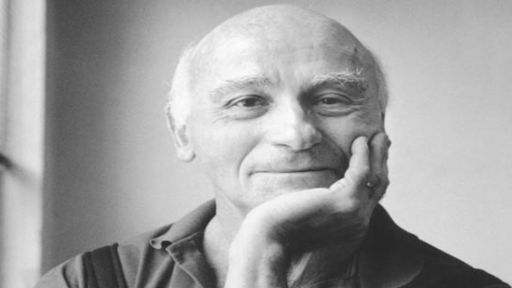For nearly sixty years, Alwin Nikolais was modern dance’s pioneer of multimedia. Among his best known performances are “Masks, Props, and Mobiles” (1953), “Totem” (1960), and “Count Down” (1979). Nikolais would often present his dancers in constrictive spaces and costumes with complicated sound and sets, designed to confuse the process of dance. By placing obstacles in the dancers’ way, he focused their attention on the physical tasks of overcoming those obstacles. Nikolais viewed the dancer not as an artist of self-expression, but as a talent who could investigate the properties of physical space and movement.
In 1949, while teaching in Colorado, Nikolais met a young dancer named Murray Louis. Louis’ technique and attention to physicality impressed Nikolais. Working closely, the two began to create work that questioned the basic foundations of modern dance. At the time, Nikolais was proposing a theory he called “decentralization.” Decentralization held that in depersonalizing dancers through costume and design they could be liberated from their own forms. For Louis, this decentralization cut through to the very heart of dance. Using sound collage and changing images projected onto both the stage and the dancers, Nikolais could shift the focus away from any one individual dancer, and concentrate on the overall effect of the production.
In New York, Louis began dancing for The Nikolais Dance Company, improving his technique and expanding his conception of dance. For Nikolais, this was an opportunity to choreograph for a dancer whose physical ability and critical involvement in dance were perfectly compatible with his new work. In 1953, while continuing to perform for Nikolais, Louis formed his own company. Unlike Nikolais, Louis both choreographed and performed his own work. Through the intimate relationship of their two directors, The Murray Louis Dance Company and the Nikolais Dance Theater created a dialogue that pushed the boundaries of contemporary avant-garde dance.
Over their forty years of collaboration Nikolais and Louis brought their vision to every part of the world. In 1978 Nikolais choreographed A “Ceremony for Bird People” in France. The piece, shown in a city street, was performed by local gymnasts. For Nikolais, the use of athletes instead of artists was a continuation of his experiments with “decentralization.” Using ropes hanging from trees and a float moving down the middle of the road, Nikolais created a public performance that was almost completely separate from the traditional practices of dance. Experimental techniques such as these allow “A Ceremony for Bird People” to combine the precision of modern choreography with the spontaneity of a parade. It is the combination of seemingly disparate elements that motivate the works of both Louis and Nikolais.
Through their constant experimentation, Alwin Nikolais and Murray Louis have inspired generations of young choreographers to move beyond the limits of contemporary dance. In May of 1993, Alwin Nikolais died in New York. Among his many great honors were the 1987 National Medal of Arts awarded by President Ronald Reagan and the French Ministry of Culture’s subsidizing of a school dedicated to his teachings. It is through the continued work of organizations such as this and through the continued work of Murray Louis that the experimentation of both men remain a challenge to new generations.



